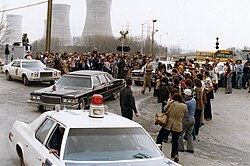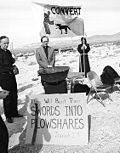Anti-nuclear movement in the United States
For many years the anti-nuclear movement in the United States succeeded in delaying or halting commitments to build some new nuclear plants.[1][2][3] Anti-nuclear campaigns that captured national public attention in the 1970s involved the Calvert Cliffs Nuclear Power Plant, Seabrook Station Nuclear Power Plant, Diablo Canyon Power Plant, Shoreham Nuclear Power Plant, and the Three Mile Island accident.[2] More recent targeted campaigning has related to the Indian Point Energy Center, Oyster Creek Nuclear Generating Station,[4] Pilgrim Nuclear Generating Station,[5] Salem Nuclear Power Plant,[6] Vermont Yankee Nuclear Power Plant,[7][8] Idaho National Laboratory,[9] proposed Yucca Mountain waste repository,[10][11] the Hanford Site,[12] the Nevada Test Site,[13] Lawrence Livermore National Laboratory,[14][15] and transportation of nuclear waste from the Los Alamos National Laboratory.[16] Many different groups have been involved in various protests and demonstrations over the years.
More than eighty anti-nuclear groups are operating, or have operated, in the United States. These include: Abalone Alliance, Clamshell Alliance, Greenpeace USA, Institute for Energy and Environmental Research, Musicians United for Safe Energy, Nevada Desert Experience, Nuclear Control Institute, Nuclear Information and Resource Service, Public Citizen Energy Program, Shad Alliance, and the Sierra Club.
Anti-nuclear protests reached a peak in the 1970s and 1980s and grew out of the environmental movement.[17] Campaigns that captured national public attention involved the Calvert Cliffs Nuclear Power Plant, Seabrook Station Nuclear Power Plant, Diablo Canyon Power Plant, Shoreham Nuclear Power Plant, and Three Mile Island.[2]
Beginning in the 1980s, many anti-nuclear power activists began shifting their interest, by joining a rapidly growing nuclear freeze movement, and the primary concern about nuclear hazards in the USA changed from the problems of nuclear power plants to the prospects of nuclear war.[18] On June 12, 1982, one million people demonstrated in New York City's Central Park against nuclear weapons and for an end to the cold war arms race. It was the largest anti-nuclear protest and the largest political demonstration in American history.[19][20] International Day of Nuclear Disarmament protests were held on June 20, 1983 at 50 sites across the United States. There were many Nevada Desert Experience protests and peace camps at the Nevada Test Site during the 1980s and 1990s.
More recent campaigning by anti-nuclear groups has related to several nuclear power plants including the Enrico Fermi Nuclear Power Plant,[21][22] Indian Point Energy Center,[23] Oyster Creek Nuclear Generating Station,[24] Pilgrim Nuclear Generating Station,[5] Salem Nuclear Power Plant, and Vermont Yankee Nuclear Power Plant.[8] There have also been campaigns relating to the Y-12 Nuclear Weapons Plant,[25] the Idaho National Laboratory,[9] Yucca Mountain nuclear waste repository proposal,[11] Lawrence Livermore National Laboratory,[14]
Some scientists and engineers have expressed reservations about nuclear power, including: Barry Commoner, S. David Freeman, John Gofman, Arnold Gundersen, Mark Z. Jacobson, Amory Lovins, Arjun Makhijani, Gregory Minor, M.V. Ramana, Joseph Romm and Benjamin K. Sovacool. Scientists who have opposed nuclear weapons include Paul M. Doty, Hermann Joseph Muller, Linus Pauling, Eugene Rabinowitch, M.V. Ramana and Frank N. von Hippel.
References
- ↑ Nuclear Politics
- ↑ 2.0 2.1 2.2 Social Protest and Policy Change: Ecology, Antinuclear, and Peace Movements p. 44.
- ↑ Lights Out at Shoreham: Anti-nuclear activism spurs the closing of a new $6 billion plant
- ↑ "Oyster Creek's time is up, residents tell board". Archived from the original on 2007-09-30. Retrieved 2008-05-19.
- ↑ 5.0 5.1 Pilgrim Watch
- ↑ "UNPLUG Salem". Archived from the original on 2008-09-27. Retrieved 2008-05-19.
- ↑ "Vermont Yankee License Renewal". Archived from the original on 2008-04-27. Retrieved 2008-05-19.
- ↑ 8.0 8.1 "Eleven arrested in latest protest over Vermont Yankee". Archived from the original on 2016-03-03. Retrieved 2021-09-26.
- ↑ 9.0 9.1 "Keep Yellowstone Nuclear Free". Archived from the original on 2009-11-22. Retrieved 2008-05-19.
- ↑ "Four Score Organizations Express Opposition to Yucca Mountain Nuclear Waste Dump". Archived from the original on 2008-11-19. Retrieved 2008-11-04.
- ↑ 11.0 11.1 "Deadly Nuclear Waste Transport". Archived from the original on 2005-03-08. Retrieved 2008-05-19.
- ↑ "Hanford History". Archived from the original on 2008-02-07. Retrieved 2008-05-19.
- ↑ 22 Arrested in Nuclear Protest
- ↑ 14.0 14.1 "Hundreds Protest at Livermore Lab". Archived from the original on 2013-01-17. Retrieved 2008-05-19.
- ↑ More than 80 people arrested at annual protest at Livermore lab
- ↑ About CCNS
- ↑ Herbert P. Kitschelt. Political Opportunity and Political Protest: Anti-Nuclear Movements in Four Democracies British Journal of Political Science, Vol. 16, No. 1, 1986, p. 62.
- ↑ Lisa Lynch (2012). "'We don't wanna be radiated:' Documentary Film and the Evolving Rhetoric of Nuclear Energy Activism" (PDF). American Literature Ecocriticism Issue.
- ↑ Jonathan Schell. The Spirit of June 12 Archived 2019-05-12 at the Wayback Machine The Nation, July 2, 2007.
- ↑ "1982 - a million people march in New York City". Archived from the original on 2008-05-16. Retrieved 2014-07-09.
- ↑ Groups petition against new nuclear plant
- ↑ "Fermi 3 opposition takes legal action to block new nuclear reactor". Archived from the original on 2010-03-30. Retrieved 2014-07-09.
- ↑ Hudson River Lovers Fight to Shutter Aging Nuclear Power Plant
- ↑ Oyster Creek's time is up, residents tell board Archived 2007-09-30 at the Wayback Machine Examiner, June 28, 2007.
- ↑ Stop the Bombs! April 2010 Action Event at Y-12 Nuclear Weapons Complex
Anti-nuclear Movement In The United States Media
A sign pointing to an old fallout shelter in New York City.
Women Strike for Peace during the Cuban Missile Crisis in 1962.
This view of downtown Las Vegas shows a mushroom cloud in the background. Scenes such as this were typical during the 1950s. From 1951 to 1962 the government conducted 100 atmospheric tests at the nearby Nevada Test Site.
President Jimmy Carter leaving Three Mile Island for Middletown, Pennsylvania, April 1, 1979
Logo of the Nuclear Information and Resource Service
Members of Nevada Desert Experience hold a prayer vigil during the Easter period of 1982 at the entrance to the Nevada Test Site.
Archived 2017-10-14 at the Wayback Machine,









